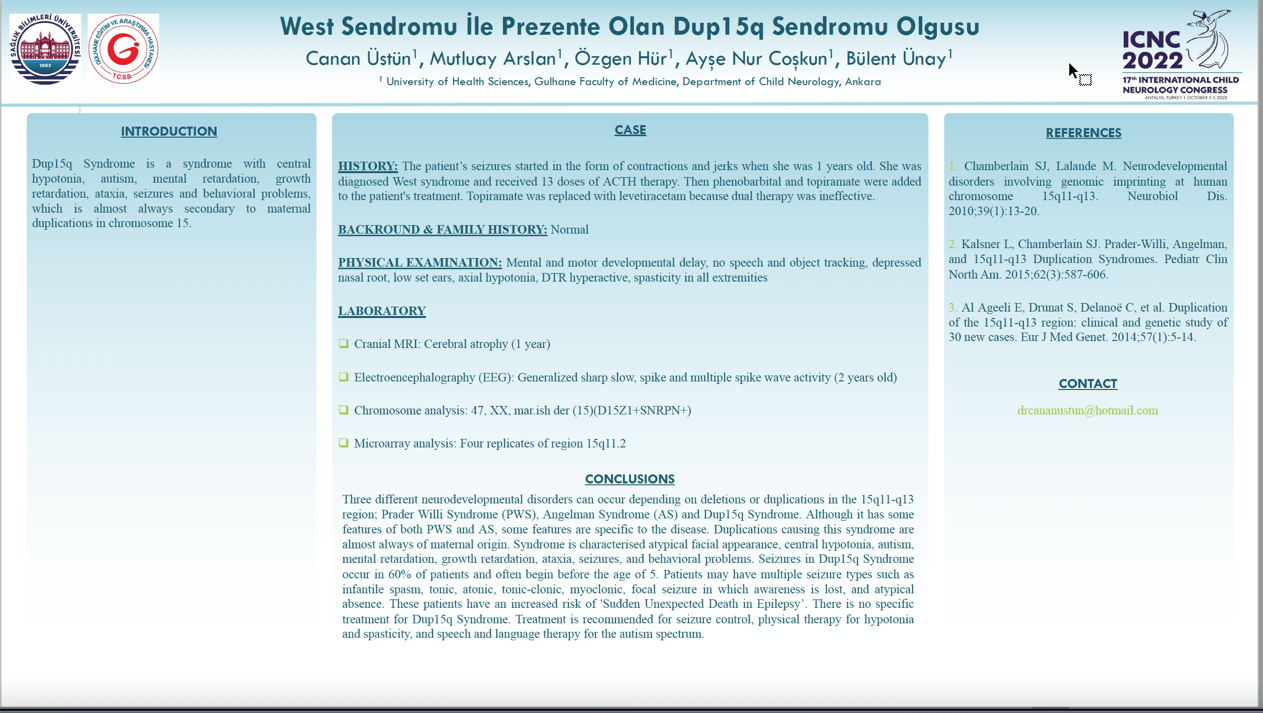A Case of Dup15q Syndrome Presenting with WEST Syndrome
Canan Üstün, Mutluay Arslan, Ayşe Nur Coşkun, Özgen Hür, Bülent Ünay
Three different neurodevelopmental disorders occur due to deletions or duplications in the 15q11-q13 region. These are; Prader Willi Syndrome (PWS), Angelman Syndrome (AS), and Dup15q Syndrome. Although Dup15q Syndrome carries some features of both PWS and AS, some features are specific to the disease. Dup15q Syndrome is characterized with central hypotonia, autism, mental retardation, growth retardation, ataxia, seizures, and behavioral problems. Duplications causing this syndrome are almost always of maternal origin. Seizures occur in 60% of patients and often begin before 5 years of age. Patients may have multiple seizure types such as infantile spasm, tonic, atonic, tonic-clonic, myoclonic, focal onset impaired awareness seizures and atypical absence. Patients with Dup15q syndrome have an increased risk of 'Sudden Unexpected Death in Epilepsy'. In this article, due to its rarity, we present a patient with myoclonic jerks, head drop seizures, hypotonia and growth retardation, hypsarrhythmia in her EEG, and finally diagnosed with Dup15q syndrome.
Keywords: Epilepsy, Dup15q Syndrome, infantile spasm, West Syndrome, genomic imprinting
Canan Üstün
Gülhane Training and Research Hospital of the University of Health Sciences
Turkey
Mutluay Arslan
Gülhane Training and Research Hospital of the University of Health Sciences
Turkey
Ayşe Nur Coşkun
Gülhane Training and Research Hospital of the University of Health Sciences
Turkey
Özgen Hür
Gülhane Training and Research Hospital of the University of Health Sciences
Turkey
Bülent Ünay
Gülhane Training and Research Hospital of the University of Health Sciences
Turkey
Three different neurodevelopmental disorders occur due to deletions or duplications in the 15q11-q13 region. These are; Prader Willi Syndrome (PWS), Angelman Syndrome (AS), and Dup15q Syndrome. Although Dup15q Syndrome carries some features of both PWS and AS, some features are specific to the disease. Dup15q Syndrome is characterized with central hypotonia, autism, mental retardation, growth retardation, ataxia, seizures, and behavioral problems. Duplications causing this syndrome are almost always of maternal origin. Seizures occur in 60% of patients and often begin before 5 years of age. Patients may have multiple seizure types such as infantile spasm, tonic, atonic, tonic-clonic, myoclonic, focal onset impaired awareness seizures and atypical absence. Patients with Dup15q syndrome have an increased risk of 'Sudden Unexpected Death in Epilepsy'. In this article, due to its rarity, we present a patient with myoclonic jerks, head drop seizures, hypotonia and growth retardation, hypsarrhythmia in her EEG, and finally diagnosed with Dup15q syndrome.
Keywords: Epilepsy, Dup15q Syndrome, infantile spasm, West Syndrome, genomic imprinting
Canan Üstün
Gülhane Training and Research Hospital of the University of Health Sciences
Turkey
Mutluay Arslan
Gülhane Training and Research Hospital of the University of Health Sciences
Turkey
Ayşe Nur Coşkun
Gülhane Training and Research Hospital of the University of Health Sciences
Turkey
Özgen Hür
Gülhane Training and Research Hospital of the University of Health Sciences
Turkey
Bülent Ünay
Gülhane Training and Research Hospital of the University of Health Sciences
Turkey

Canan Üstün
Gülhane Training and Research Hospital of the University of Health Sciences Turkey
Gülhane Training and Research Hospital of the University of Health Sciences Turkey